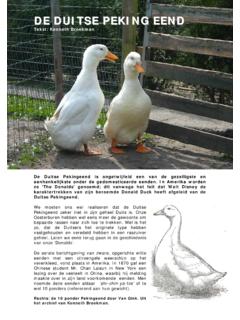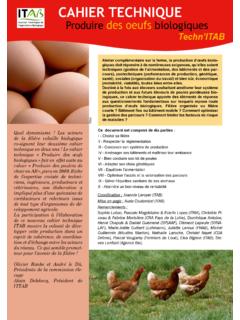Transcription of CHICKENS IN AFRICA - Aviculture Europe
1 CCHHIICCKKEENNSS IINN AAFFRRIICCAA Above and below: CHICKENS in Democratic Republic of Congo. Photos courtesy of Dr. Nassim Moula. By Luuk Hans (NL) My two elder daughters stayed in AFRICA , in all, for more than a year and a half - in Mozambique, Sierra Leone, South AFRICA and Uganda. Although no poultry fanciers themselves, they know their way around CHICKENS . They both took photos of poultry because they know I am a fanatic poultry breeder. This opportunity has been an additional reason for me also to look into African chicken breeds. This article is a combination of my research - together with Elly Vogelaar, editor of Aviculture Europe - and the experiences of my two daughters. I realise that AFRICA is a big continent; according to DAGRIS Domestic Animal Genetic Resources Information System, there are 90 local chicken breeds! Of course we could not cover all breeds!
2 Indigenous poultry AFRICA does not have many - if at all - standardized poultry breeds. CHICKENS , held in rural villages, have been here for ages and are adapted to the local environment and conditions. They are being kept and bred for traits such as hardiness, but are not standardized according to their looks . Nevertheless, poultry farming is very important in most rural areas of AFRICA . Now what exactly are indigenous CHICKENS ? Here in AFRICA , these are CHICKENS that have been bred from local species, originally from higher up the continent, and they spread downwards in the years before colonisation. The basic domestication of the CHICKENS is centuries old, and as the local populations moved around the Sub-Saharan areas of the continent, so too did the CHICKENS . The terminology used to describe these CHICKENS is sometimes confusing, as they are referred to as indigenous , native , local or traditional.
3 Although these terms all have their specific definition, they will be used arbitrary in this article. The local CHICKENS in AFRICA exhibited a wide phenotypic varia-bility in plumage, shank, eye, earlobe, comb, skin, feather distri-bution and body size. They are hardy, often have a high degree of disease resistance, do not need much feed (in other words: excellent feed conversion rate) and have utility use (eggs and meat). Left: Democratic Republic of Congo. Notice the small size of this local hen, compared to the chair. Photo: Dr. Nassim Moula. On the other hand they take long to reach sexual maturity, have a small mature carcass weight and the hens produce only few eggs per year; about 2-4 clutches, each of about 10 12 eggs. However, they hatch their own eggs and brood the chicks hence ensuring that the farmer has a continuous supply of replacement stock.
4 Traits of local breeds include hardiness to inclement weather conditions, resistance to some local poultry diseases, and multi-purpose use in the free-range production system. Fortunately we are starting to realize that these local CHICKENS are valuable reservoirs of genes, and even though there is still little or no information on their genetic makeup, indigenous poultry needs to be maintained for the purpose of conserving the wide gene pool that these breeds represent. The birds we see in villages are often a mixture of (hybrid) breeds. Obviously, the way they look is less important than their economic performance! In spite of that: naked necked and frizzled poultry is popular, but not just for their looks; this is also a consequence of the weather conditions. Naked necks and frizzled poultry have less feathers and stand hot weather better than birds with normal feathers.
5 Right: Frizzled hen in Mozambique. Photo: Rosalie Hans. Right: Naked Neck in Uganda. Photo: Marissa Hans. There is a lack of information on the local breeds. What is known is that the rural poultry population in most African countries accounts for more than 60 percent of the total national poultry population; village poultry is more widely spread in rural AFRICA than any other livestock species. Also known is that poultry plays an important role in rituals. In Uganda for example, local poultry are often used in ceremonies, rituals, sacrifices and gifts. Indeed, for most social-cultural and religious purposes, the required sex and colours of the CHICKENS are prescribed. For example, in Buganda, a cock with spotless white plumage is used as an offer to Mukasa - god of waters. Eggs of local CHICKENS play a major role in the Luo tradition and culture, where they can be used to cleanse or to complete a ritual, like eggs being used in the last funeral rites ceremonies.
6 In Uganda, again as an example, most of the birds end up being consumed, even the commercial egg type chicken . Eggs and meat of the local CHICKENS are often the only source of animal protein for the resource-poor households. CHICKENS are also sold at the market to meet unforeseen expenses. Below: CHICKENS for selling at the market, Congo. Photo: Dr. Nassim Moula. The birds usually sold from the village flock are surplus males, pullets and non-productive hens, large sized birds, old hens and even sick birds. The market price for free range birds is usually stable due to traditional taste values. Local chicken meat is considered tastier and stronger flavoured than commercial broiler meat. Left: Commercial breeding in Sierra Leone. Photo: Rosalie Hans. Right: Commercial breeding in Uganda. Photo: Marissa Hans. On average, poultry farming is very important in AFRICA . In many African countries rural poultry accounts for a high percentage of the national production of poultry eggs and meat.
7 Poultry keeping is mostly the women s job. Countries must have a certain level of prosperity to raise rare local breeds. Certainly in less developed countries there must be an economic reason in doing so. The driving force for the breeding of Game Fowl is not eggs or meat, but the money, which could and still can be made in the pit. In AFRICA there are three Game breeds: Reunion Game, Madagascar Naked Neck and Natal Game. In one of our coming issues we will publish more on South African Game Fowl. Right: Rural CHICKENS in South AFRICA . Photo: Marissa Hans. Back to the rare, indigenous poultry breeds. African breeds The African poultry breeds are hardly known in the West. Still there are many of them - indigenous CHICKENS or locally developed breeds - the more so since chicken meat is very popular in AFRICA . Often there is no distinct identification of the local chicken types; identification is made on the basis of plumage structure (frizzle, naked neck) or plumage colour.
8 South AFRICA has three native chicken breeds that are standardised: the Venda, Ovambo and the Potchefstroom Cuckoo. The Phefstroom Koekoek (Cuckoo) is a South African chicken breed developed in the 1960 s at the Potchefstroom Agricultural College, in the city of otche CHICKENS of the Potch (as it is e CHICKENS are well Potchefstroom, by Professor Chris Marais. The breed was intended as an excellent dual purpose, free ranging bird with excellent laying capabilities as well as a good meat production. Pure Koekoeks have an exclusively black-and-white barred (= Koekoek/Cuckoo) appearance. The Potchefstroom Koekoek is the only South African chicken breed that is briefly described in the Western Hemisphere (Germany). This breed is a cross between black Australorp, white Leghorn and barred Plymouth Rock.)
9 One could argue that most African breeds are crosses, but many breeds, in the Western Hemisphere as well, were created in the 20th century by crossing other breeds. Potchefstroom CHICKENS . Photos courtesy of Wickedfood Earth Talso called) are sex-linked. In other words: you can tell on day one the males from the females, judging by their colour. These nativadapted to the South African climate. It is a hardy breed which will produce eggs consistently without consuming excessive amounts of feed. This makes it quite a popular breed especially when considering that it is a good table fowl too. The egg laying qualities of the Koekoek have led to its use in small scale egg production. The Potchefstroom Koekoek looks a bit like a cuckoo Leghorn or Noord Holland Blue. The weight is to 4 kg for the males and to 3 kg for the females.
10 Potchefstroom is a city in the North West Province of South AFRICA . It is situated on the banks of the Mooirivier, roughly 120 km (75 mi) west-southwest of Johannesburg. In 2007 the local municipality was changed from Potchefstroom Municipality to Tlokwe Municipality. Tlokwe is also the name that is proposed to replace the town's name. The Venda (Also known as: Lebowa-Venda) is a mottled bird the basic colours of the Venda are similar to the indigenous cattle and goats, namely black, white and brown, with white and black as the predominant colours. It has a single comb and weighs roughly 3 kg (cock) and kg (hen). Left: A Venda cock. Photo: Marissa Hans. Below: A Venda pullet at the Show. Photo courtesy of Poultry Club South AFRICA . In 1979, a veterinarian, Dr Naas Coetzee, noticed a distinctive new breed in Venda, a region in the North of South AFRICA , and named it after the region.






